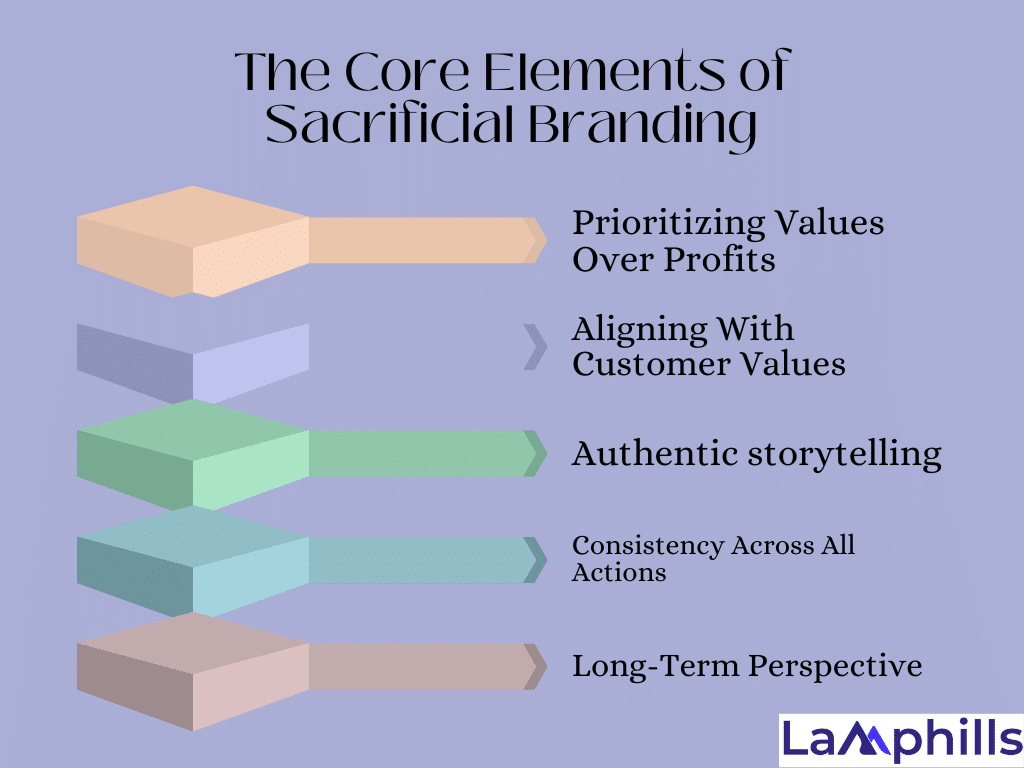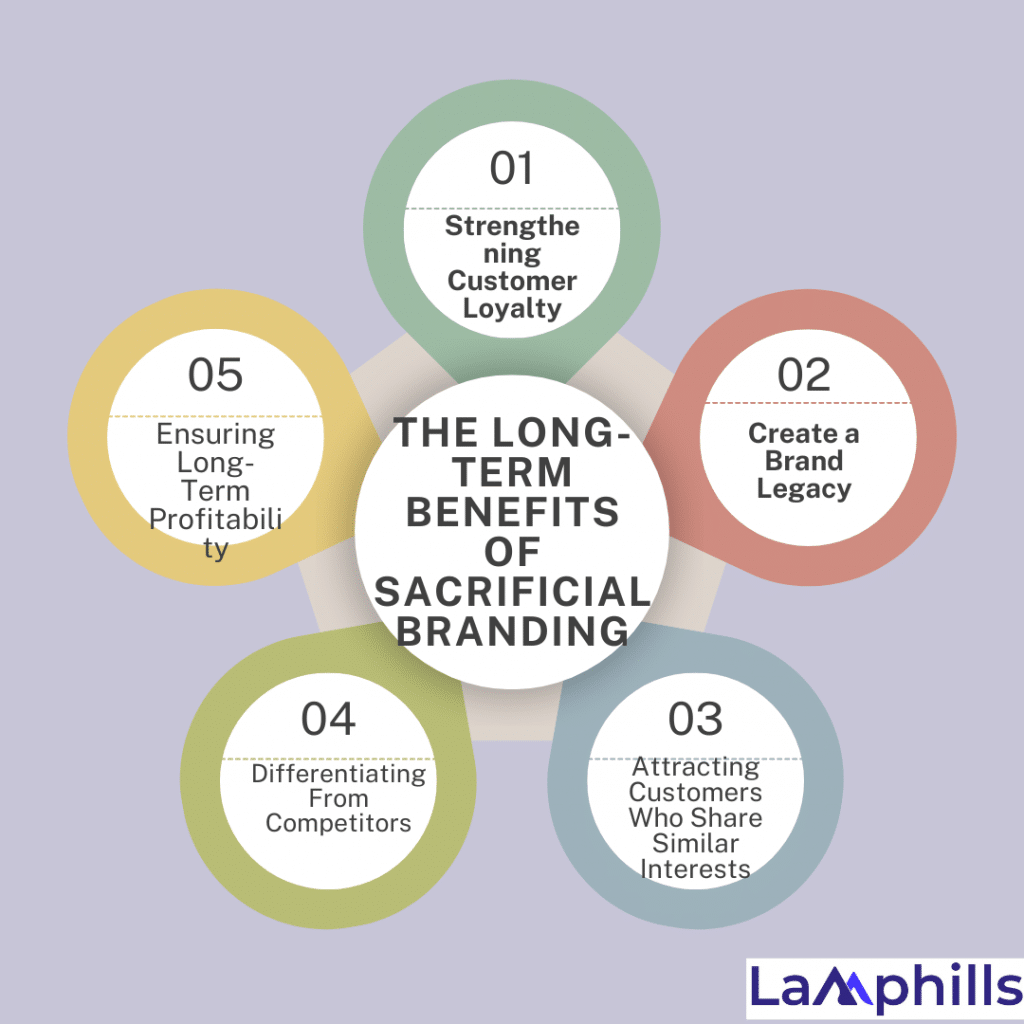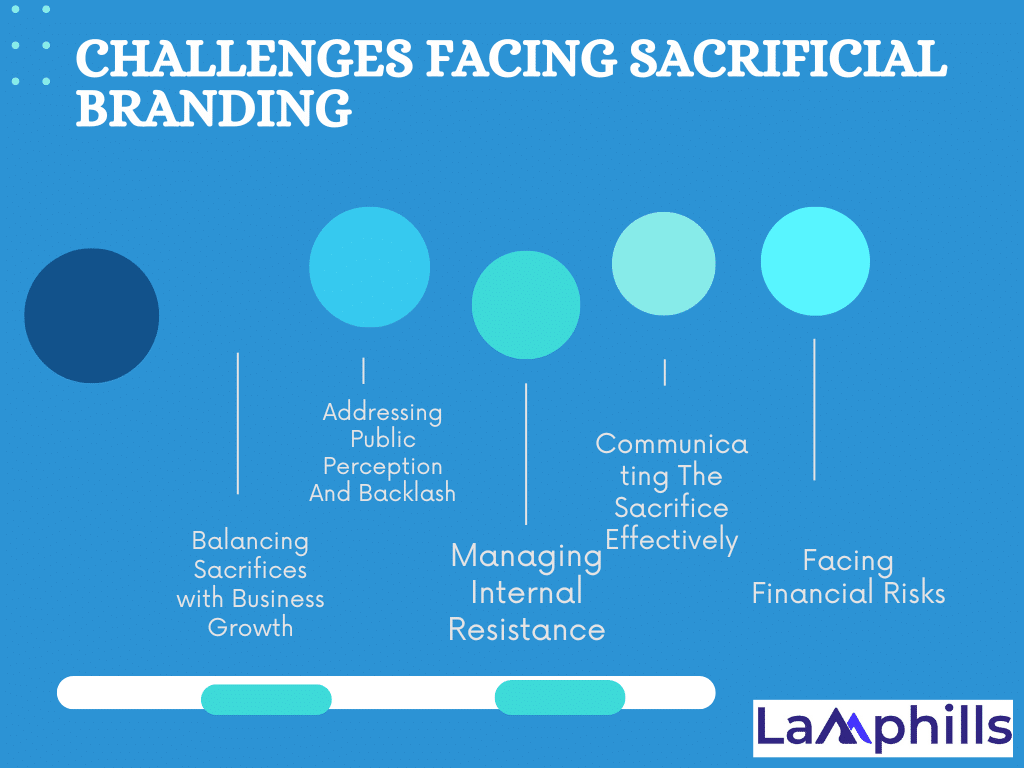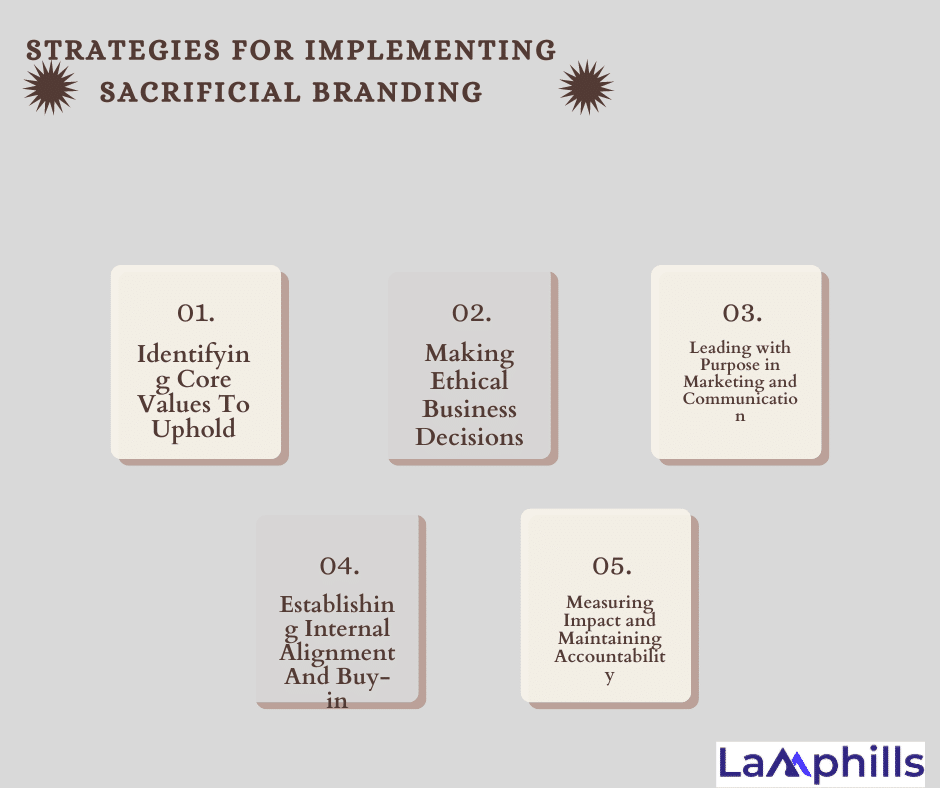For many years, businesses faced a difficult decision: should they prioritize short-term earnings or establish long-term loyalty through their basic values? The answer is that sacrificial branding is the practice of making decisions that are consistent with your brand’s ideals, even if it means foregoing immediate profits.
It’s about thinking long-term, developing stronger relationships with customers, and eventually creating a brand heritage that will survive the test of time. I’ve witnessed firsthand how businesses battle with this delicate balance, and I’ve discovered that the organizations that thrive are typically those that are ready to forego fast success in favor of a larger goal. Read on to be enlightened,
Key Takeaways
- Sacrificial branding emphasizes prioritizing a brand’s core values, even at the expense of short-term profits, leading to stronger customer loyalty and brand legacy in the long run.
- Consumers are drawn to brands that make genuine sacrifices, such as ethical sourcing or sustainable practices, which communicate a deeper commitment beyond just profits—building trust and long-term loyalty.
- Sacrificial branding thrives on authentic storytelling, which humanizes brands. Explaining the “why” behind tough decisions fosters emotional connections with customers, strengthening brand loyalty.
- While sacrificial branding may involve immediate financial sacrifices, the long-term benefits include a loyal customer base, differentiation from competitors, and a lasting, values-driven legacy that ensures enduring profitability.
What Is Sacrificial Branding?

Sacrificial branding is all about making difficult decisions that match your brand’s core values, even if it means foregoing immediate profits or company success. This approach goes against the grain in a world where short-term victories are frequently praised. Sacrificial branding promotes long-term loyalty and brand integrity over what is convenient or profitable in the now.
To put it simply, it’s like taking the scenic route instead of the more direct highway. The highway may get you there faster, but the scenic road provides a fuller, more meaningful experience—one in which you can connect with the people and surroundings around you. And in branding, connectivity is everything.
A strategy that brands adopt when they recognize the long-term value of building trust with their customers. Trust leads to loyalty, and loyalty leads to sustainable growth. But this kind of branding is not without its challenges—sometimes, it requires businesses to turn down deals, alter their production methods, or make decisions that might hurt their bottom line in the short term.
Case Studies of Brands That Exemplify Sacrificial Branding
Some of the most well-known examples of sacrificial branding come from iconic companies like Patagonia and Ben & Jerry’s. These brands have become leaders in their industries, not just because they offer great products but because they consistently prioritize their values—even when it means giving up short-term profits.
#1. Patagonia
Let’s start with Patagonia. This outdoor wear firm is well-known for its dedication to environmental sustainability. They’ve made several financially risky decisions over the years, but those sacrifices have reinforced their brand and built a loyal consumer base. A well-known example is Patagonia’s Don’t Buy This Jacket campaign.
On Black Friday, a day when most businesses aim to sell as much as possible, Patagonia produced an advertisement urging customers to think twice before purchasing new products, including one of their own. The lesson was clear: don’t acquire more than you need and, if possible, repair what you currently have.
On the surface, it appeared like an odd business decision. Why would a firm purposefully prevent customers from purchasing its products? But this is the core of sacrificial branding. By making that short-term commitment, Patagonia strengthened its environmental beliefs and drew a new wave of environmentally-minded customers.
And, guess what? Despite the campaign’s theme, Patagonia saw a rise in sales! The brand’s honesty struck a chord with its audience, and people wanted to support a firm that they believed was attempting to make a difference.
#2. Ben & Jerry’s
Another great example of sacrificial branding comes from Ben & Jerry’s, the ice cream company famous for its social activism. From the beginning, Ben & Jerry’s founders were vocal about their commitment to social justice, sustainability, and ethical sourcing. One of their most notable sacrifices came when they took a strong stance on climate change. They not only supported political movements advocating for environmental protection but also changed the way they sourced ingredients to minimize their environmental impact.
Now, altering supply chains to focus on ethical and sustainable sourcing often comes with a hefty price tag. For Ben & Jerry’s, this meant increased costs for ingredients like Fairtrade-certified cocoa and sugar. They could have easily sourced cheaper alternatives and boosted their profit margins, and no one would have batted an eye. But by making that sacrifice, they communicated to their customers that they stood by their values, no matter the cost. And again, it worked in their favor. Their customers stayed loyal, not just because of the taste of their ice cream, but because they believed in the company’s mission. People were—and still are—willing to pay a premium for a product that aligns with their values.
Trust me, sacrificial branding may appear to be a risky strategy at first, especially when revenues are involved. However, brands that adhere to their values and make difficult decisions following their beliefs end up creating something far more precious than short-term gains: trust, loyalty, and an enduring brand heritage.
Whether it’s Patagonia advising people not to buy their items or Ben & Jerry’s taking a blow to assure ethical sourcing, these companies have demonstrated that foregoing immediate earnings in favor of ideals pays off in the long term. It’s more than just business success; it’s about building a brand that represents something broader than the items it sells. And that, ultimately, is what keeps customers coming back again and again.
The Core Elements of Sacrificial Branding

Let’s look into what makes sacrificial branding effective. Maintaining your principles can be difficult, especially when it requires making difficult judgments. Here are five key components that guide effective sacrificial branding:
#1. Prioritizing Values Over Profits
Sacrifices take many forms. It could entail declining a profitable commercial offer that violates your brand’s ethics or committing to more expensive sustainable practices. These decisions may harm in the near term, but the long-term rewards, such as increased trust and loyalty, are important. This is because customers appreciate it when a brand sticks hard to its beliefs, even if it means sacrificing profits.
#2. Aligning With Customer Values
Understanding your customers’ values and ensuring that your brand matches them are critical components of sacrificial branding. People want to support companies that match their values. When you prioritize shared values, you build a stronger relationship with your audience.
#3. Authentic storytelling
Sacrificial branding is more than just making ethical decisions; it also entails communicating those decisions authentically. Storytelling is one of the most effective ways to communicate your brand’s devotion to its values. Sharing the “why” behind difficult decisions humanizes your brand and makes people feel emotionally invested in your journey.
Think about Patagonia’s “Don’t Buy This Jacket” campaign. It was more than just about sustainability; it was about telling the story of why they care so much about trash reduction. That transparency appealed to consumers who shared similar beliefs, cementing their commitment.
#4. Consistency Across All Actions
Consistency is an important factor in sacrificial branding. If you make values-based decisions, they must be reflected in all aspects of your organization, from operations to marketing. Customers will notice if your actions don’t match your words, and the trust you’ve worked so hard to establish may swiftly disappear.
Consistency is vital for branding. When your principles are obvious across all touchpoints—whether in product sourcing, corporate culture, or customer service—customers know they can rely on your authenticity.
#5. Long-Term Perspective
Patience is required for sacrificial branding. It’s about taking the long view rather than chasing short-term gains. While losing short-term earnings might be difficult, brands that prioritize long-term loyalty gain from increased consumer trust, advocacy, and ongoing growth.
Ben & Jerry’s is an excellent example of a company that has constantly prioritized social justice problems, even if it means alienating certain market demographics. Their long-term dedication has resulted in a devoted, passionate following that prioritizes their integrity over immediate ease.
In conclusion, sacrificial branding is about making difficult decisions that are consistent with your principles, even if it means losing out in the short term. However, with patience, openness, and an emphasis on authenticity, brands may establish strong, long-term connections with customers who share their values.
The Long-Term Benefits of Sacrificial Branding

Sacrificial branding is more than just feeling good or doing the right thing; it is a deliberate decision that can result in real, measurable benefits for a business. Here are five major long-term benefits of adopting this approach:
#1. Strengthening Customer Loyalty
Customers are more likely to remain loyal to a business when they see it uphold its ideals, especially when it is challenging. Loyalty is built on trust, and sacrificial branding is one of the most effective methods to gain and maintain that trust.
For example, once my client’s company rejected the unsustainable supplier I mentioned earlier, we discovered something incredible. Customers not only stayed with us, but many became brand advocates. They frequently mentioned our experience to their friends and family, saying that our commitment to values was the reason they chose us over competitors. Sacrificing short-term gains led to an increase in word-of-mouth referrals and deeper customer loyalty.
#2. Create a Brand Legacy
Sacrificial branding not only increases client loyalty, but also helps to establish a brand heritage. When a company consistently makes values-driven decisions, it becomes more than just a business; it represents something larger.
Take Ben & Jerry’s as an example. They’ve become a shining example of ethical business practices by continually aligning their company with social justice and sustainability initiatives. They are known not only for their excellent ice cream but also as a business that cares about the planet. This type of legacy, created over time, guarantees that the brand remains relevant and valued long after specific goods have faded from memory.
#3. Attracting Customers Who Share Similar Interests
Customers who share your beliefs are drawn in by sacrifice branding. Customers in today’s market are more socially concerned than ever before. They want to support brands that share their values and priorities, whether it’s environmental sustainability, ethical labor practices, or community support.
For example, when we focused on ethical sourcing for my client’s clothing brand, we saw that our target consumer was buying into our goal as well as the products. These like-minded clients were more likely to continue with us since they thought they were contributing to a worthwhile cause. Sacrificial branding assists businesses in attracting and retaining customers who share common values.
#4. Differentiating From Competitors
In a crowded market, it’s easy to become lost amid competitors. Sacrificial branding can be an effective approach to setting your business apart from the competition. While other companies may emphasize profits at any cost, your dedication to values distinguishes you.
For example, Patagonia’s Don’t Buy This Jacket campaign did more than only promote their environmental objective; it also highlighted their distinction from fast-fashion firms that encourage excessive spending. This distinction helped them stand out and solidified their devoted consumer base. Sacrificial branding enables firms to establish a distinct personality in the marketplace.
#5. Ensuring Long-Term Profitability
While sacrificial branding may require foregoing short-term income, it can result in higher long-term profitability. Customers who trust and understand your principles are more inclined to stick around for the long haul, providing steady, sustainable growth.
Brands like TOMS Shoes, which have embraced sacrificial branding, have demonstrated that emphasizing social impact over short-term profit does not imply forsaking financial success. They’ve developed a profitable business strategy by attracting a dedicated consumer base that believes in their cause. Sacrificial branding may be a slower path to success, but it is frequently more sustainable and effective in the long run.
To summarize, sacrificial branding provides long-term rewards that significantly surpass short-term expenditures. Staying true to your beliefs strengthens customer loyalty, creates a lasting legacy, attracts like-minded consumers, differentiates you from the competition, and generates long-term profitability.
Challenges Facing Sacrificial Branding

While sacrificial branding provides long-term advantages, it also has its own set of obstacles. Here are five major challenges that businesses frequently face while adopting this approach:
#1. Balancing Sacrifices with Business Growth
One of the most difficult aspects of sacrificial branding is striking the right balance between short-term sacrifices and long-term growth. Prioritizing values over profits frequently results in short-term revenue losses or changes in market share.
It is difficult to strike a balance between retaining profitability and being faithful to your brand’s beliefs. For example, adopting a more sustainable manufacturing technique may increase prices and reduce profit margins, making it harder to balance growth with ethical decision-making.
#2. Addressing Public Perception And Backlash
Taking a strong stance on social or environmental concerns may result in public attention or even retaliation. While some customers may support your position, others may reject or criticize your decisions.
Nike drew flak after partnering with controversial characters in their advertising efforts. Despite this, they remained dedicated to their beliefs, acknowledging that public perception might not always be positive. Handling backlash while being true to your brand’s objective necessitates effective communication and a clear sense of purpose.
#3. Managing Internal Resistance
Within an organization, not everyone may be willing to make sacrifices for the sake of ideals. Leadership, stockholders, and even staff may oppose moves that appear to reduce short-term profitability. Convincing internal stakeholders that sacrificial branding pays off, in the long run, might be challenging.
I’ve personally watched boardroom arguments in which leadership disagreed on the choice to reject a profitable contract because it did not correspond with the company’s principles. It needs great leadership and vision to keep the entire team committed to such sacrifices.
#4. Communicating The Sacrifice Effectively
Making a compromise is not enough; communicating that decision to customers and stakeholders is equally important. If clients are uninformed of a brand’s sacrifices made by its beliefs, the advantages of those acts may be overlooked.
Brands must be upfront and straightforward in describing why they make particular decisions and how they reflect their beliefs. Even the most values-driven acts may go undetected or misunderstood by the public in the absence of good communication.
#5. Facing Financial Risks
Sacrificial branding can expose businesses to considerable financial dangers. Whether it’s declining a significant partnership, rising production costs to uphold ethical standards, or passing up quick profit prospects, the financial consequences might be overwhelming.
These compromises might be especially risky for smaller enterprises. There’s always the question of how long a brand can make these decisions without harming its business line. However, those who take the risk and succeed are frequently rewarded with increased consumer loyalty and a distinct market position.
In summary, while sacrificial branding has enormous potential to develop long-term trust and brand legacy, it is fraught with obstacles such as balancing expansion, managing public perception, overcoming internal resistance, guaranteeing clear communication, and limiting financial risks. Brands must be prepared to overcome these challenges to succeed in the long run.
Strategies For Implementing Sacrificial Branding

Successful sacrificial branding implementation necessitates careful planning and a strong commitment to values. Here are five strategies to help firms through this process:
#1. Identifying Core Values To Uphold
The first stage in sacrificial branding is to determine the essential principles that your brand will uphold, no matter the cost. These values must be clearly stated, articulated, and understood by both your team and your consumers.
Consider what your company stands for beyond profitability when deciding which ideals are worth compromising for. Patagonia, for example, is well-known for its environmental dedication, continually favoring sustainability even at the expense of short-term earnings. Defining your basic beliefs helps to influence decision-making when faced with difficult options.
#2. Making Ethical Business Decisions
Sacrificial branding frequently entails making ethical decisions that may not yield immediate financial benefits. Identifying key occasions when ethical choices might boost your brand’s reputation is critical to this strategy.
For example, when selecting suppliers or partners, prioritizing sustainability, fair labor practices, or diversity may result in greater expenses but will reinforce your brand’s credibility. Balancing these ethical decisions with long-term economic success necessitates strategic thinking, ensuring that your sacrifices are consistent with your ideals while not risking your company’s financial health.
#3. Leading with Purpose in Marketing And Communication
To be effective, sacrificial branding must incorporate your principles into all aspects of your marketing and communication. Purpose-driven messaging helps people engage with your brand at a deeper level.
TOMS Shoes, for example, effectively conveys its “One for One” program, in which they forego profit margins in exchange for providing a pair of shoes with each transaction. This language, which is integrated into their marketing, emphasizes that their company is about more than just money; it is about making a real difference in the world. Storytelling is essential for communicating these beliefs and sacrifices, as it helps customers feel emotionally invested.
#4. Establishing Internal Alignment And Buy-in
To apply sacrificial branding, it is critical to establish internal alignment behind your brand’s values. Your employees, leaders, and stakeholders must all understand and embrace the principles that guide your actions. Sacrifices that affect short-term revenues might be difficult to make without internal support.
Brands that are successful with sacrificial branding often build a strong company culture around their values. Ben & Jerry’s, for instance, involve their employees in social justice causes, making sure everyone is aligned with the brand’s mission. This internal cohesion strengthens the company’s commitment to making difficult, value-driven decisions.
#5. Measuring Impact and Maintaining Accountability
Finally, adopting sacrificial branding necessitates a thorough grasp of how your sacrifices affect both your brand and the world. It’s critical to monitor the outcomes of your decisions, both in terms of consumer loyalty and overall social or environmental impact.
Being transparent and accountable to your audience is essential. Patagonia, for example, not only sacrifices revenues by adopting sustainable materials, but they also publish impact studies to demonstrate to clients how such decisions are consistent with their mission. This transparency fosters trust and demonstrates the brand’s long-term commitment to its ideals.
In short, executing sacrificial branding entails recognizing fundamental values, making ethical company decisions, communicating with purpose, fostering internal alignment, and measuring impact. By following these tactics, businesses can build trust, loyalty, and a lasting legacy while staying true to their values.
What is sacrificial branding, and how does it differ from traditional branding strategies?
This question focuses on understanding the core concept of sacrificial branding and how it contrasts with profit-driven branding approaches.
How do brands effectively communicate their sacrifices to build customer loyalty?
This touches on the importance of storytelling and transparency in ensuring that customers understand and appreciate a brand’s values-based decisions.
What challenges do businesses face when adopting sacrificial branding, and how can they overcome them?
Explore the risks and hurdles, such as balancing values with profitability, that companies need to navigate when choosing sacrificial branding strategies.
Conclusion
Sacrificial branding isn’t for the faint of heart. This is because it necessitates difficult decisions, a long-term outlook, and a dedication to being loyal to your principles. However, the benefits—strong consumer loyalty, a lasting legacy, and a greater connection with your target audience—are well worth it.
In my experience, the brands that stick to their ideals even when it’s difficult are the ones that not just survive, but prosper over time. So, the next time you confront a difficult decision, keep in mind that short-term sacrifice may be the route to long-term success. Allow your values to guide your decisions, and your customers will follow.






